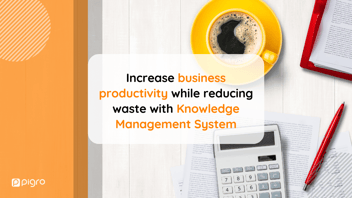Business resources definition
Every company, in order to be stable and long-lasting, must be founded on certain pillars that aim to give it a structure capable of surviving over time.
One of these pillars is made up of the company's resources, an indispensable and essential element for a company. But what are resources in business?
A common definition of business resources says that “resources are an organization’s assets and are thus the basic building blocks of the organization”.
Resources, in fact, represent all the elements over which the organization acts directly (internal resources), but also those over which it does not have immediate control (external resources).
Resources and business processes
A concept closely linked to that of resources are processes. A business process is an activity or set of activities that can accomplish a specific organizational goal. Business processes should have purposeful goals, be as specific as possible and have consistent outcomes.
In a company, it is therefore necessary to establish a good management of resources, both internal and external, together with the creation of a structure for processes, without which they would not be exploited to the full.
Have you ever wondered what resources actually mean in the context of a business?
Understanding the meaning of resources in business is crucial in establishing a stable and long-lasting company.
Resources are the essential pillars of business strategy, but what are key business resources?
They can be classified into two basic categories, tangible and intangible corporate resources:
- Tangible corporate resources: include all physical and financial resources that can be shown on the corporate balance sheet, as they are easily quantifiable and measurable.
- Intangible corporate resources: all that concern technology and production methods, innovation capabilities, access to information, but also reputation and corporate culture, customer loyalty and relations with stakeholders, elements that are more difficult to measure.
Among the latter, corporate human resources are particularly relevant: they are closely linked to the people who are part of an organization and are represented by individual skills, communication and collaboration skills, staff motivation, etc.
Intangible resources are therefore more difficult to cultivate and put to use, which is why it is essential to know how to optimize them in order to gain a competitive advantage.

What constitutes the essential elements that a company needs to achieve its goals and objectives?
These are known as key business resources, which can be classified into tangible and intangible categories.
Key business resources are the essential elements that a company uses to achieve its goals and objectives. These resources can be classified into tangible and intangible categories. Tangible resources refer to physical and financial assets such as machinery, buildings, and cash. On the other hand, intangible resources are non-physical assets such as technology, innovation capabilities, corporate culture, reputation, and customer relations.
Corporate human resources are also a crucial intangible resource that can significantly impact a company's success. The skills, knowledge, and expertise of the workforce, their motivation, communication, and collaboration skills are all essential components of corporate human resources.
Effective management of these resources is essential for a company's success and stability. It involves establishing a good structure for processes and optimizing resources to gain a competitive advantage. By synchronizing internal and external processes, identifying avoidable slowdowns, investing in innovative technology, and having a rapid resolution capability, a company can minimize waste and maximize productivity.
Key business resources are the foundation upon which a company builds its success. By effectively managing these resources, a company can achieve its objectives, increase productivity, and reduce waste.
How to manage business resources
A good approach to managing resources and processes can help prevent wasted time and money for the organization. However, very often the right strategies are not put in place to avoid these losses, leading to a vicious cycle that is difficult to escape. For this reason, it is important to understand what is the importance of business resources and how to recognize the main sources of wasted resources.
1. Synchronization
A firm where internal and external processes are synchronized can optimize time and minimize loss.
Often, however, this does not happen, and a single slowdown in a process or department means that others involved are unable to proceed with their tasks, leading to extended timescales which, in turn, lead to further stoppages.
These delays are wasteful, both in time, as employees will have to stop their work while waiting for other divisions, and in money, as they will not be able to fulfil their tasks quickly and focus on other activities.
In fact, smooth processes make efficient use of company resources, increasing productivity and profits.
2. Processes
In this way, the firm can be more effective and more efficient in its operations.
It is necessary to pay attention to the flow of these processes in order to understand if there are avoidable slowdowns and how they can be resolved.
This is where you can find out why synchronization is not happening and which processes are creating problems.
This monitoring must take place periodically because the creation of a workflow involves the organization of many aspects and takes into account many elements, sometimes unpredictable, that only with a constant analysis can not turn into slowdowns and, consequently, loss of time and resources.
3. Technology
One of the main reasons employees quit is to work in an uninspiring environment: backward procedures, outdated technology, and frustration with the tools available that do not meet objectives.
Often top management doesn't see the potential of investing cyclically in innovation, but having up-to-date tools brings many benefits. Let's look at some of them.
-
Business resources planning solutions: with the advancement of information technology, increasingly combined with artificial intelligence, software has emerged that allows you to automate a whole range of processes related to various areas (such as marketing, logistics, human resources, and customer service). Thanks to these tools, it is possible to eliminate repetitive and uninspiring tasks that take up employees' time, allowing staff to channel all their energy into tasks with higher added value;
-
Enhancement of business resources: having innovative technologies that make work easier allows employees to work in the best conditions, eliminating their sense of frustration related to wasted time and increasing satisfaction. For leadership, this translates into better management of the company's human resources, while also increasing the employee retention rate - the organization's ability to keep its employees within the company.
4. Resolution speed
As we have seen in the previous points, it is essential to establish a strategy for optimizing firm resources. Sometimes, however, constant analysis and monitoring are not enough to prevent waste.
For this reason, it is important to have a rapid resolution capability: to detect the problem in the shortest possible time, having shared procedures that allow acting promptly and in a coordinated manner among the various figures involved.
A problem is often unpredictable. What can be predicted, however, is the process of resolving it in the shortest possible time.
Being aware of what the most common business wastes may be, allows each company to put in place strategies to avoid them or to act promptly should they arise.
The productivity of a company, in fact, is not only given by the gains it makes, but also by all the waste of time and resources it manages to avoid.
Read more:
Do you want more information on Pigro? Contact us!



